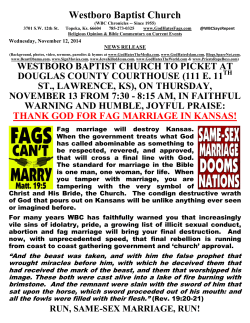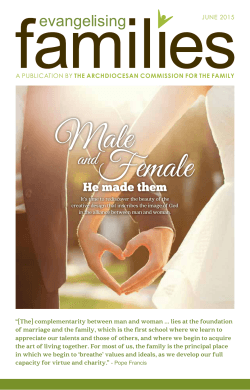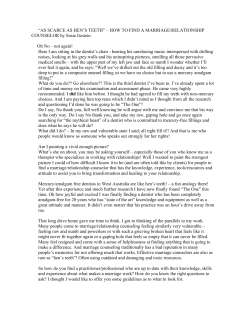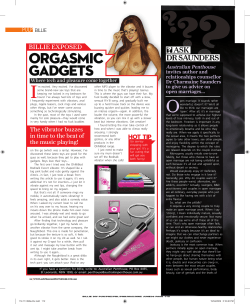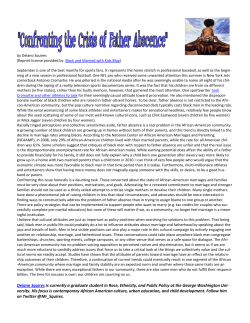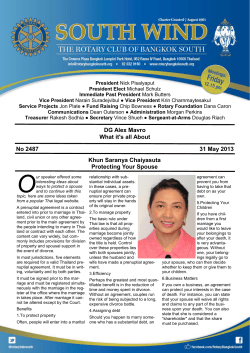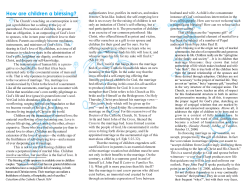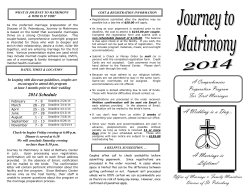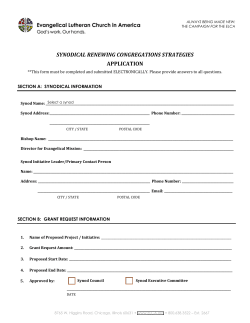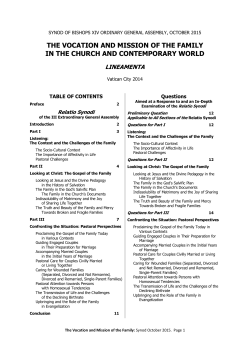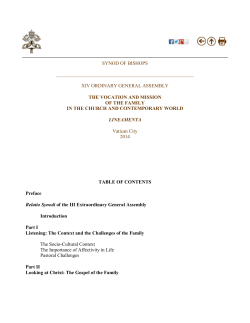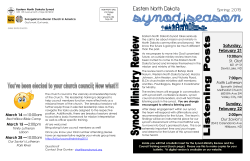
Giving a Voice to Families - Catholic Archdiocese of Melbourne
Giving a Voice to Families A Follow-Up Questionnaire in Preparation for the 2015 Synod on the Family CATHOLIC ARCHDIOCESE OF MELBOURNE 18th December 2014 Dear Friends Following the Extraordinary Synod on the Family in October, Pope Francis and the Synod of Bishops are once again seeking responses to questions as part of their preparation for the 2015 Synod. Your participating in this survey is one way of taking an active role in shaping how we share the Gospel and respond to the needs of those around us. While not essential, you may also wish to read the Relatio Synodi2 - the final summary of the Extraordinary Synod in October 2014 - before responding. The Relatio also includes the full set of questions. The online survey will be open until midnight on Tuesday 10th February 2015. While using the online survey is preferred, hard copy responses can be submitted up to Friday 6th February 2015. This next stage of the process aims to extend the work of the previous Synod. It is not designed to revisit what has already been discussed. With this in mind, the questions have been framed to draw out ways in which the Church can better listen, look to Christ and then act to support marriage and family life. We look forward to receiving your response. For further information, please contact: Life, Marriage and Family Office PO Box 146, East Melbourne VIC 8002 Phone: (03) 9287 5576 Fax: (03) 9926 5617 Email: lmf@cam.org.au Website: www.cam.org.au/lifemarriagefamily In response to feedback during the previous survey in 2013, a simplified questionnaire has been developed. Responses can be submitted through the online questionnaire1. The same questions are provided below. You do not have to answer every question. You may choose to focus on those relating to a particular area of expertise or interest. 1. www.surveymonkey.com/s/Synod2015 2. www.vatican.va/roman_curia/synod/documents/rc_synod_doc_20141209_lineamenta-xiv-assembly_en.html 2 Questions for 2015 Synod on the Family 1. Does the final Synod Document offer an adequate account of marriage and the family or does more need to be said? 15. What can be done to provide an effective and comprehensive catechesis of marriage and the family, starting in early life and involving life-long formation? 2. What is being done to help families cope in the midst of great social changes? What more could be done, especially in helping them to understand those changes? 16. Do we need to shape a new language in the area of marriage and the family? If so, how? 17. How effective is the marriage preparation that is being offered? How might it be more effective? 3. What is being done to ensure that governments support marriage and the family in every way possible? What more could be done? 18. Do we need to do more to support couples in the early years of married life? If so, what? 4. What is being done to support strong families? What more could be done? 19. What place do marriage and the family have in the RCIA? 5. What is being done to help families in trouble? How might troubles be prevented? How effectively is pastoral care being offered to families “on the periphery”? 20. What movements and associations are there in the area of marriage and the family? Can these contribute more broadly and effectively? 21. What are the challenges of mixed marriages and interreligious marriages? How can we meet them more effectively? 6. How can we help individuals and couples grow in affective or emotional maturity? 22. Apart from sacramental marriage, what can be done to foster appreciation of “natural marriage”? 7. What needs to be done to equip ordained ministers and others to work effectively in the area of marriage and the family? 23. How can we respond compassionately to people in irregular unions while remaining faithful to the teaching of Christ and the Church? 8. Does the encounter with Christ shape pastoral care in the area of marriage and the family? How well is Scripture used in the pastoral care of couples and families? 24. Does the process of declaring nullity need to be simpler, less difficult and less costly? 9. What values are in fact most important in the area of marriage and the family in the eyes of young people and married couples? What counter-values are evident? 25. How can we respond better to people of same-sex attraction and their families? 26. How can we communicate more effectively the Church’s vision of married love and the beauty and dignity of parenthood as presented, for example, in Humanae Vitae? 10. How can couples living together before marriage or in de facto relationships be encouraged to choose marriage? 11. What is being done to help people understand the greatness and beauty of the indissolubility of marriage? What more could be done? 27. What more can be done to promote a sense of parenthood as divine vocation? What more can be done to help parents in their educational mission, especially in transmitting the faith to their children? 12. How can we help people understand better the power of a relationship with God in marriage and of the grace of the Sacrament in their lives? 28. How can we encourage adoption and fosterparenting as signs of fruitful generosity? 29. What more can we do to prevent abortion and foster a genuine culture of life? 13. How can we help people understand better that marriage is a key part of God’s original plan and is therefore a way of fulfilment not confinement, joy not sorrow? 30. How can we help all people see that no-one is beyond God’s mercy? 14. How can the family be helped to become “the domestic Church” with a missionary vocation? How can we help develop a family spirituality? 3
© Copyright 2025
